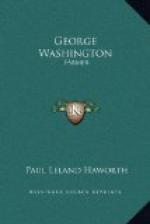Union Farm lay just below the Mansion House Farm and contained nine hundred twenty-eight acres of arable land and meadow. In 1793 it had, in Washington’s words, “a newly erected brick barn, equal, perhaps, to any in America, and for conveniences of all sorts, particularly for sheltering and feeding horses, cattle, &c. scarcely to be exceeded any where.” A new house of four rooms was building, and there were quarters for fifty odd negroes. On this farm was the old Posey fishery and ferry to Maryland.
Dogue Run Farm, of six hundred fifty acres, lay back of Union Farm and upon it in 1793 stood the grist mill and later a distillery and the famous sixteen-sided “new circular barn, now finishing on a new construction; well calculated, it is conceived, for getting grain out of the straw more expeditiously than the usual mode of threshing.” It had a two-room overseer’s house, covering for forty odd negroes, and sheds sufficient for thirty work horses and oxen. Washington considered it much the best of all his farms. It was this farm that he bequeathed to Nelly Custis and her husband, Lawrence Lewis, and upon it they erected “Woodlawn,” which is shown in the photograph herewith reproduced.
Not long since I rambled on foot over the old estate and had an opportunity to compare the reality, or what remains of it, with Washington’s description. I left the Mansion House, often visited before, and strolled down the long winding drive that runs between the stunted evergreens and oaks through the old lodge gate and passed from the domain, kept trim and parklike by the Association, out upon the unkempt and vastly greater part of the old Mount Vernon.
It was early morning, about the hour when in the long past the master of the estate used to ride out on his tour of inspection. The day was one of those delicious days in early autumn when earth and sky and air and all things in nature seem kindly allied to help the heart of man leap up in gladness and to enable him to understand how there came to be a poet called Wordsworth. Meadow-larks were singing in the grass, and once in an old hedgerow over-grown with sweet-smelling wild honeysuckle I saw a covey of young quails. These hedgerows of locust and cedar are broken now, but along the old road to the mill and Pohick Church and between fields the scattered trees and now and then a bordering ditch are evidences of the old owner’s handiwork.
Then and later I visited all the farms, the site of the old mill, of which only a few stones remain, the mill stream, the fishery and old ferry landing. I walked across the gullied fields and examined the soil, I noted the scanty crops they bear to-day and gained a clearer idea of what Washington’s problem had been than I could have done from a library of books.




